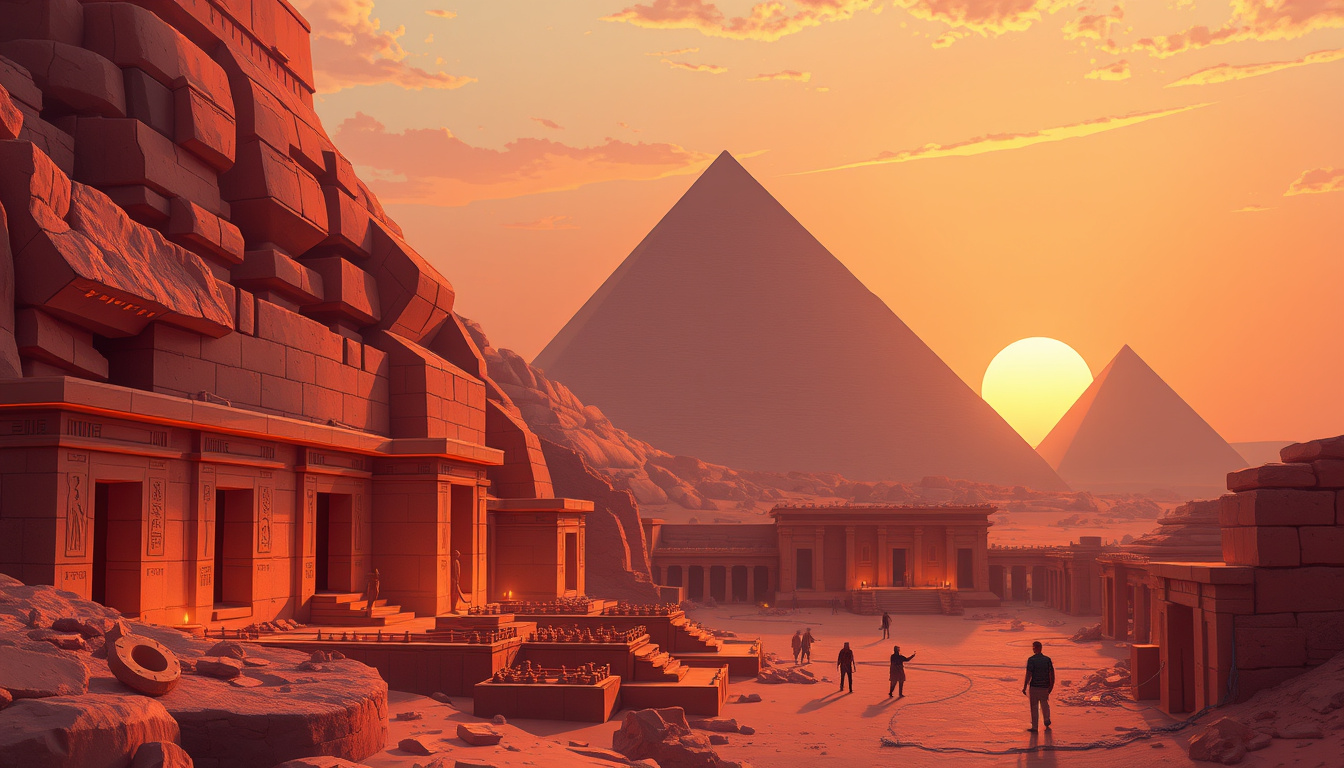In March 2025, the archaeological community was electrified by revelations that sound like the plot of an adventure film: researchers from Italy and Scotland announced the discovery of what they believe is a hidden city beneath Egypt’s Giza pyramid complex, a magnificent archaeological site that has captivated historians for centuries. This significant discovery, if verified, may reshape our understanding of ancient Egyptian civilization and its monumental pyramids, which have stood for over 4,500 years.
The Discovery: A Vast Underground Network
The research team, led by Dr. Maria Conti from the University of Bologna and Dr. Alasdair Fraser from the University of Edinburgh, employed advanced imaging technology to reveal what they describe as a sprawling network of underground structures extending approximately 6,500 feet below the Great Pyramid of Giza. This discovery was made possible through innovative techniques: a combination of satellite-based Synthetic Aperture Radar (SAR) and seismic vibration analysis, which produced high-resolution, three-dimensional images of the sub-surface. The scans exhibited a complex array of chambers, corridors, and open spaces organized in a manner reminiscent of modern architectural design, suggesting sophisticated engineering skills from a civilization long past.
Perhaps the most intriguing feature of this alleged underground city is the existence of eight vertical cylindrical shafts, each around twelve feet in diameter, which the researchers believe could have served various functions, including ventilation and potential astronomical purpose. Dr. Conti likened these constructions to a modern multi-story building, raising questions about their role in ancient society.
The Reaction: Public Fascination vs. Scientific Skepticism
As news of the discovery spread, it ignited widespread interest and speculation across social media and the public. Headlines celebrated the "Ancient Egyptian Underground Metropolis Found," with discussions ranging from scholarly debate to fanciful theories about extraterrestrial influences. However, the response from the archaeological community was more cautious. Renowned Egyptologist Dr. Zahi Hawass emphasized that such extraordinary claims require extraordinary proof, calling for thorough peer review and careful examination of the data.
Critics of the research have raised pertinent questions about the reliability of the SAR and seismic methodologies deployed, noting limitations in depth penetration and accuracy. Dr. Sarah Parcak, a prominent space archaeologist, cautioned that while these technologies have made considerable advances, their effectiveness at significant depths and in dense limestone environments is still uncertain. The Egyptian Antiquities Authority remains noncommittal, advocating for an independent committee to scrutinize the findings without jumping to conclusions.
The Methodology: Pushing Technological Boundaries
The research employed cutting-edge methods not previously used in such depth at Giza. The team introduced a fusion algorithm that combined spatial data from SAR with insights from passive seismic analysis, allowing them to visualize structures far beneath the surface. Their rigorous approach included analyzing existing geophysical surveys, collecting new SAR data across seasons, and interpreting it with custom machine-learning algorithms tailored for archaeological applications.
This reliance on remote sensing is indicative of a transformative era in archaeology. No longer limited to physical excavation, researchers can use advanced technologies to explore ancient sites without disturbing them, offering a more sustainable approach to archaeological investigation.
Challenges Ahead: Verification and Excavation
While the methodology appears promising, verification is a crucial next step. The team has submitted their findings for peer review, where experts will scrutinize the data and assess whether the techniques used were appropriate and effective. Ultimately, true validation requires ground-truthing – the challenging step of physically verifying the findings through excavation or minimal invasive methods.
Should the claims be substantiated, the implications would be monumental. Evidence of a city entombed beneath the pyramids would suggest a significant departure from the traditional view of the Giza plateau as primarily a necropolis. Instead, it might indicate that the site also served as a vibrant hub for administration, housing, or religious practices linked to pyramid construction.
Ethical and Cultural Implications
Excavating such a historical treasure trove involves a myriad of ethical and cultural considerations. The pyramids are not merely structures; they symbolize Egypt’s cultural heritage and identity. The Ministry of Antiquities has outlined a cautious, phased plan for potential investigations, balancing scientific pursuit with preservation, as any disturbance could risk damaging these ancient monuments.
Furthermore, the history of claims at Giza is rife with exaggeration and misrepresentation, necessitating a cautious approach in evaluating any new findings. As such, the archaeological community remains vigilant in discerning the truth from possible misinterpretations rooted in geological phenomena.
Conclusion: Awaiting Revelations
As we navigate the excitement surrounding the potential discovery of an underground city beneath the pyramids, it serves as a reminder that archaeological knowledge evolves through rigorous inquiry and patience. The interplay of modern technology and ancient history promises not only the chance to uncover lost stories but also the opportunity to challenge and expand our understanding of ancient Egyptian civilization.
The coming months are poised to be critical as data is analyzed and reviewed, and as the Egyptian authorities weigh the merits of excavating this possible urban complex. In the world of archaeology, every potential breakthrough invites a wave of skepticism alongside curiosity, underscoring the importance of thorough investigation and respectful stewardship of our past. Whether this hidden city exists or is simply a mirage will soon be revealed, continuing the age-old quest to uncover the secrets of ancient Egypt.

